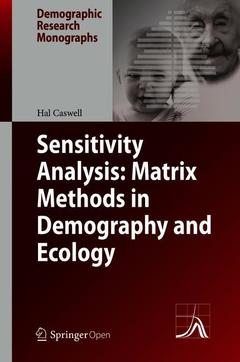Sensitivity Analysis: Matrix Methods in Demography and Ecology, 1st ed. 2019 Demographic Research Monographs Series
Auteur : Caswell Hal

This open access book shows how to use sensitivity analysis in demography. It presents new methods for individuals, cohorts, and populations, with applications to humans, other animals, and plants. The analyses are based on matrix formulations of age-classified, stage-classified, and multistate population models. Methods are presented for linear and nonlinear, deterministic and stochastic, and time-invariant and time-varying cases. Readers will discover results on the sensitivity of statistics of longevity, life disparity, occupancy times, the net reproductive rate, and statistics of Markov chain models in demography. They will also see applications of sensitivity analysis to population growth rates, stable population structures, reproductive value, equilibria under immigration and nonlinearity, and population cycles. Individual stochasticity is a theme throughout, with a focus that goes beyond expected values to include variances in demographic outcomes.
The calculations are easily and accurately implemented in matrix-oriented programming languages such as Matlab or R. Sensitivity analysis will help readers create models to predict the effect of future changes, to evaluate policy effects, and to identify possible evolutionary responses to the environment.
Complete with many examples of the application, the book will be of interest to researchers and graduate students in human demography and population biology. The material will also appeal to those in mathematical biology and applied mathematics.
I Introductory and methodological: 1 Introduction. Sensitivity analysis: what and why?.- 2 Matrix calculus and notation.- II Linear models: 3 The sensitivity of population growth rate: three approaches.- 4 Sensitivity analysis of longevity and life disparity.- 5 Individual stochasticity and implicit age dependence.- 6 Age[1]stage-classified models.- III Time-varying and stochastic models: 7 Transient population dynamics.- 8 Periodic models.- 9 LTRE decomposition of the stochastic growth rate.- IV Nonlinear models: 10 Sensitivity analysis of nonlinear demographic models.- V Markov chains: 11 Sensitivity analysis of discrete Markov chains.- 12 Sensitivity analysis of continuous Markov chains.
This open access book provides a comprehensive presentation of sensitivity analysis for demographic models
Applicable to populations of humans, other animals, and plants
Develops mathematical theory and shows examples of application
Considers all types of population models (linear and nonlinear, deterministic and stochastic, age-classified and stage-classified)
Date de parution : 04-2019
Ouvrage de 299 p.
15.5x23.5 cm
Disponible chez l'éditeur (délai d'approvisionnement : 15 jours).
Prix indicatif 52,74 €
Ajouter au panier


